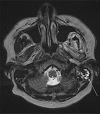Carcinomatous myelitis and meningitis after a squamous cell carcinoma of the lip
- PMID: 24575013
- PMCID: PMC3934787
- DOI: 10.1159/000358049
Carcinomatous myelitis and meningitis after a squamous cell carcinoma of the lip
Abstract
Background: Nervous central system metastases from head and neck squamous cell carcinoma (SCC) are rare. We report an exceptional case of isolated leptomeningeal and spinal cord involvement few years after the diagnosis of invasive SCC of the lip.
Case report: A 33-year-old man with a history of infracentimetric carcinoma of the lip developed back pain associated with progressive neurological disorders leading to paraplegia. This atypical presentation led to initial misdiagnosis, but radiological and cytological explorations finally confirmed the diagnosis of leptomeningeal and intramedullar secondary spinal cord lesions from his previously treated head and neck SCC. Systemic targeted therapy with epidermal growth factor receptor inhibitor and intrathecal chemotherapy led to prolonged disease stabilization.
Conclusion: To our knowledge, this is the first case of isolated neurological metastases from a head and neck SCC. Combination of systemic targeted therapy and intrathecal chemotherapy may be effective in such cases.
Keywords: Head and neck carcinoma; Meningitis; Spinal cord metastasis; Squamous cell.
Figures



References
-
- Binder-Foucard F, Belot A, Delafosse P, Woronoff A, Bossard N: Estimation nationale de l'incidence et de la mortalité par cancer en France entre 1980 et 2012. Partie 1 – Tumeurs solides. Institut de veille sanitaire 2013.
-
- Redman BG, Tapazoglou E, Al-Sarraf M. Meningeal carcinomatosis in head and neck cancer. Report of six cases and review of the literature. Cancer. 1986;58:2656–2661. - PubMed
-
- Törnwall J, Snäll J, Mesimäki K. A rare case of spinal cord metastases from oral SCC. Br J Oral Maxillofac Surg. 2008;46:594–595. - PubMed
-
- Murray JJ, Greco FA, Wolff SN, Hainsworth JD. Neoplastic meningitis. Marked variations of cerebrospinal fluid composition in the absence of extradural block. Am J Med. 1983;75:289–294. - PubMed
-
- Sullivan LM, Smee R. Leptomeningeal carcinomatosis from perineural invasion of a lip squamous cell carcinoma. Australas Radiol. 2006;50:262–266. - PubMed
Publication types
LinkOut - more resources
Full Text Sources
Other Literature Sources
Research Materials

